This website is supported by its readers. If you click one of my links I may earn a commission. I am also a participant in the Amazon affiliates program and I will also earn a commission from qualified purchases.
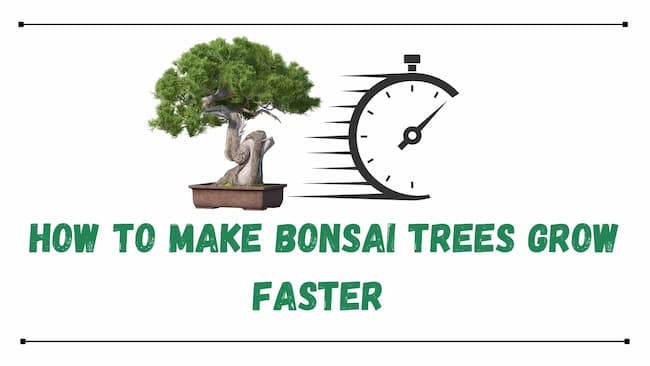
With winter fast approaching, I’m shifting my focus to next year and thinking about a few strategies to help my trees grow faster than they usually would. While it’s most definitely daunting, there are a few quick tips I found that should do the job. So, how do you make bonsai trees grow faster?
To make bonsai trees grow faster, grow in a larger pot at the right temperature and ensure you maintain thin roots and a thick trunk. Consider growing from a cutting instead of seeds and using defoliation and pruning to speed up the growth process.
So, how long does the average bonsai tree take to grow? And what bonsai species are fast growing? Keep reading to find out more!
Just a quick heads up, over the past three years of running Plantpaladin, hundreds of people have asked for product recommendations. As such, You can find my favorite indoor bonsai tree here (link takes you to Bonsaiboy), my favorite outdoor bonsai tree (link takes you to Bonsaiboy), or have a look at all the products I recommend here.
How to make bonsai trees grow faster
To get to the bottom of how to make bonsai trees grow faster, I contacted my local gardener, visited my local botanical gardens, and even surveyed 20 plant paladin readers.
To summarise:
- Most bonsai trees, regardless of species, can be grown faster than initially anticipated.
- That said, choosing a faster-growing species, such as Maple, will yield a much faster-growing bonsai tree than a slower species, such as Jade.
- Growing your bonsai pot in a pot with much room or directly in the ground will also massively increase the speed at which your bonsai tree grows.
- Thickening the trunk of your bonsai tree, defoliating the leaves on your tree regularly, and ensuring the roots of your bonsai tree stay thin will also ensure a much faster-growing species.
- If these methods are followed, this can dramatically increase the time it takes to grow your tree and the time it takes to reach maturity.
- For example, if a Chinese Elm bonsai takes 3 to five years to grow into a mature bonsai, following these methods can speed up the process to about 2 to 4 years.
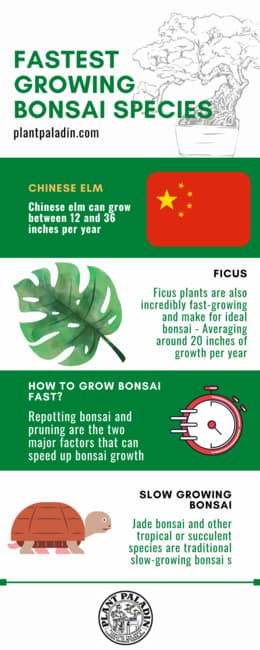
How to make bonsai trees grow faster: step-by-step
Now, this is a lot of information, so let’s break down the exact steps I would follow to dramatically speed up how long it takes to grow a bonsai tree.
Look for an Immature tree.
First, I recommend using a younger tree or cutting to speed up growing a bonsai tree.
You see, when bonsai trees reach maturity (most trees will hit this at the 5 to 10-year mark), their rate of growth will slow down substantially.
This means that when a chinese elm bonsai might grow 12 to 36 inches in its first year, by the time the tree hits year 7, this growth will drop to around 5 to 12 inches per year.
As such, to speed up the process, consider using a sapling or cutting that is less than three years old to dramatically speed up the process if you intend to grow from scratch.
Doing so will allow you to use tools like propagators to speed up the process further.
Don’t grow from seed.
Another critical tip would be to avoid growing your bonsai tree directly from seed.
While this can be incredibly rewarding, growing directly from seed can add a lengthy scarification or stratification process ( which can take a few months) to growing your tree.
Instead, I recommend growing from a young sapling or cutting off an existing tree to speed up the process dramatically.
The best option if you are really in a tight rush is to use a store-bought young bonsai tree for the process.
Provide suitable soil
One of the biggest reasons many bonsai owners see lackluster bonsai tree growth is that they just don’t provide adequate soil for their trees.
Most leave it too long before changing their soil or are just using the wrong soil, which will inhibit both root and plant growth.
While the exact type of potting soil will vary from species to species, almost all bonsai trees need an even balance of aeration, moisture retention, and moisture flow.
So, what is the best soil mix to speed up bonsai growth?
50% Akadama, 25% volcanic lava rock, 25% pumice
Should you decide to mix organic and inorganic soil mixes, I found the following works well:
50% akadama, 30%Volcanic lava rock, 20% organic mix(such as peat)
How often should I change my bonsai soil to grow my tree faster?
Consider changing your bonsai tree soil every one to two years to ensure your tree will grow as fast as possible. The following table should help:
Material | Organic or inorganic | How frequently should you change |
Peat | Organic | One per year |
Compost | Organic | One per year |
Leaf mulch | Organic | One per year |
Akadema | Inorganic | 1-2 years |
Pumice | Inorganic | 1-2 years |
Gravel | Inorganic | 1-2 years |
Lava rock | Inorganic | 1-2 years |
Kyodama | Inorganic | 1-2 years |
Grow in a bigger pot or on the ground.
If you use the correct potting soil, but your bonsai is still struggling to grow, then this is an issue with your bonsai pot.
While most bonsai trees love shallow pots, if not repotted frequently, the roots of your bonsai can start to become crushed and stop being as efficient at absorbing valuable nutrients and water from the soil.
In this scenario, you have two options:
- Repot in a larger pot
- Consider growing in the ground.
While repotting in a larger pot will be the best option for most of you reading this, If your roots are indeed crushed, then consider planting in the ground.
This will allow your roots to grow down as opposed to sideways and allow your tree to grow faster and more robust in the process.
Ensure, however, that the right temperature and conditions are met, as not all trees can survive outdoors, especially in colder climates.
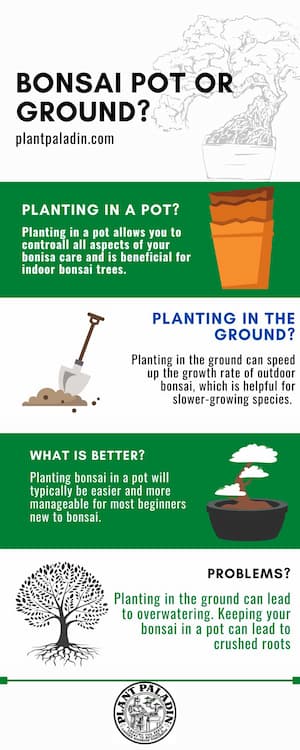
Provide the right temperature and sunlight.
Another major problem that can inhibit bonsai growth is just not growing at the right temperature or providing enough sunlight.
Most of us like to grow our bonsai trees indoors to be on the safe side.
It’s one of the reasons why indoor species such as ficus or Chinese Elm are so popular.
That said, many of us have a set-it-and-forget-it attitude regarding indoor trees.
Ensure then that your tree gets the right temperature year-round.
For most Indoor trees, this will be between 15 to 25 degrees, and for most coniferous outdoor trees, this would be between 10 to -10 degrees C.
Sunlight is also neglected far too often, and one of the big reasons your bonsai is growing slower than you would like is that it needs adequate sunlight.
In this scenario, ensure your tree gets between 4 to 8 hours of full or partial sunlight daily, regardless of where it is kept.
If growing indoors, or if you live in a gloomy environment, invest in a grow light to speed up the process.
Maintain thin roots
We touched upon this earlier on, but one of the most significant factors that impacts your bonsai tree growth will be root damage.
As most bonsai trees are grown in shallow pots, if left unchecked, the roots of your bonsai can become clumped together or damaged.
In severe cases, roots can uptear your entire bonsai, so it’s essential to ensure these are pruned regularly.
Thin roots will be the best for your bonsai tree, which will allow for perfect moisture and nutrition uptake, so it’s vital to remove any thick roots.
For most species, consider pruning the roots of your bonsai tree once per year. Pruning your bonsai roots in the off-season such as the fall, will be best as there will be less energy in the tree, allowing it ample time to recover.
Avoid doing other pruning activities simultaneously, as it is best to do one training method per tree.
To prune your bonsai roots, remove them from your bonsai pot and use a root hook to unfurl and unclump any soil.
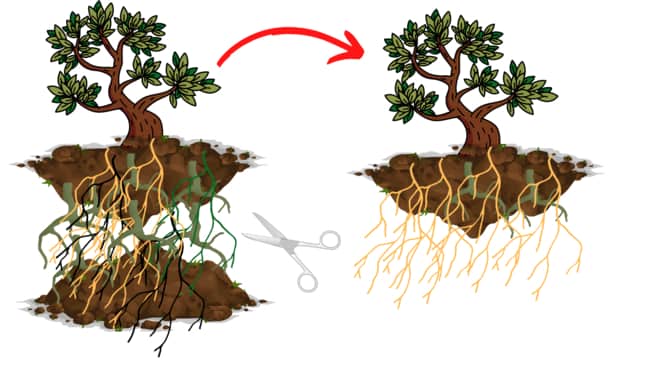
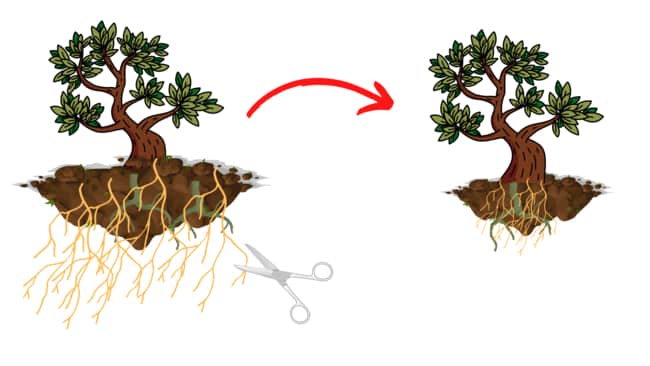
Using shears or a blade, trim back any thick roots.
Consider leaving any taproot you see if your tree has one.
Time repotting and root pruning
Repotting and pruning will be vital to speed up your bonsai tree growth.
That said, you must time this to be the most effective.
For example, if you were to undertake repotting, root pruning, defoliation, and wiring your tree all at the same time, the recovery time for your tree would take about a year.
Instead, it’s vital to time these so your tree has enough time to recover.
I recommend repotting your bonsai tree at the end of summer, say late August; this means that by the end of September/early October, you could then start work on root pruning without this impacting your tree too much.
Thicken the trunk
Another fantastic way to speed up growing your bonsai tree would be to thicken up the trunk.
Not only will this give your tree a substantial style, but a thick bonsai trunk will also transport nutrients and water throughout your tree in a much more effective way than if your bonsai trunk was thin.
So, how do I thicken my bonsai trunk?
Most bonsai trees have very different trunk styles.
For example, sumo bonsai trees have short, thick trunks that gradually taper.
Cascade bonsai, however, have thin-sized trunks that change.
To train the trunk of your Bougainvillea bonsai, the three things you will need to keep in mind are:
- How to thicken up the trunk of the tree
- How to add a taper to the trunk
- Where to add bends to the trunk of the tree.
The best way to achieve these is by doing the following:
- Growing out a sacrifice branch – this will add a lot of thickness over the trunk of your tree – grow out a branch of your tree for 3 to 5 years untouched.
- Bonsai trunk chopping – will add a significant amount of taper to the tree by chopping off the top part of your trunk.
- Removing part of the trunk – this will make it easier to add bends into the tree.
Now, like many things in this post), bonsai trunk development is a topic all onto itself, so to read up more about how to train the trunk of your tree bonsai – check out this post here.
Watch out for bugs.
One of the most inevitable parts of growing a bonsai tree indoors or outdoors will be insect infestation.
Aphids, whiteflies, and scale will all be commonplace throughout growing your tree.
While these can be dealt with quickly, these bugs can damage both the leaves and root systems of your tree.
As such, it’s crucial to inspect your bonsai tree once per week for these pests.
If infected, remove the damaged branches and leaves or use predatory insects such as wasps and ladybugs or pesticides to remove these from your tree.
Use pruning techniques
While it might sound counterintuitive, pruning your tree and removing branches and leaves can speed up the process of tree growth.
Typically, there will be two main types of pruning you can undertake to speed up tree growth:
Defoliation is removing around 75 percent of the leaves on your bonsai tree.
To do so, trim the leaf at the petiole and repeat until the leaves have been removed.
In their place, two leaves will form, ideal for achieving a thicker, denser leaf canopy at half the time.
Branch trimming can also be undertaken to speed up the process of increasing the number of secondary or tertiary branches in your tree.
Trim back the branches of your tree until only one or two nodes are left.
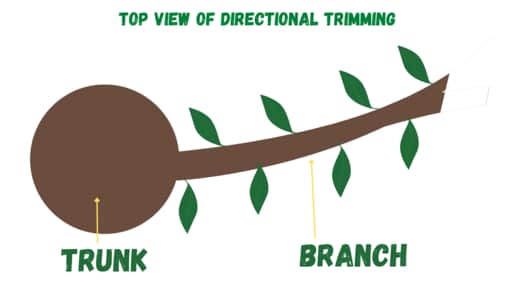
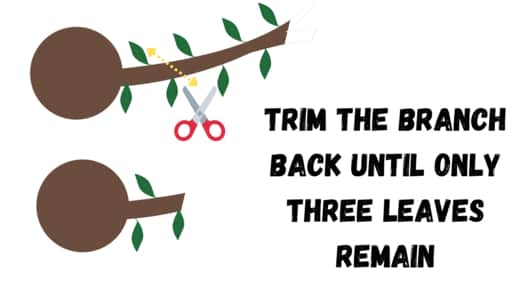
This will force new branch growth in a shorter period.

How fast do bonsai trees grow?
Most bonsai trees grow between 5 and 36 inches per year. Fast-growing bonsai trees, such as chinese elm, can mature in 3 years. Slow-growing bonsai trees such as Jade can take 5 to 7 years to mature.
How much does a bonsai tree grow in one year?
Bonsai trees grow between 2 to 36 inches annually, depending on the species. Slow-growing bonsai, such as Jade, will grow 2 to 5 inches yearly. Moderate-growing species like Juniper will grow 5 to 12 inches yearly, and fast-growing species like Chinese Elm will grow 12 to 36 inches yearly.
What are the fastest-growing bonsai species?
Chinese elm, Japanese elm, Maple, Ficus, and Pine plants are the fastest-growing species used in bonsai. These plants typically grow 12 to 36 inches annually during the growing season or 30cm to 91cm.
The fastest-growing bonsai tree species that are commonly available to buy are:
- Chinese Elm
- Japanese Elm
- Maple
- Ficus
- White Eastern Pine
- Austrian Pine
- Canary Island Pine
Bonsai species | Growth type | Time to maturity | Average growth per year |
Chinese Elm | Fast | 3 years | 12 to 36 inches |
Juniper | Moderate | 4 years | 5 to 12 inches |
Jade | Slow | 5 years | 2 to 5 inches |
Maple | Fast | 3 years | 12 to 36 inches |
Fukien Tea | Slow | 5 years | 2 to 5 inches |
Ficus | Fast | 3 years | 12 to 36 inches |
Wisteria | Slow | 5 years | 2 to 5 inches |
Cotoneaster | Moderate | 4 years | 5 to 12 inches |
Pine (most varieties) | Fast | 3 years | 12 to 36 inches |
Azalea | Slow | 5 years | 2 to 5 inches |
What is a slow growth rate?
A low bonsai tree growth rate is between 2 and 5 inches of new growth per year. This will include species such as Jade or other succulent bonsai.
What is the average growth rate?
The average bonsai tree growth rate is between 5 and 12 inches of new growth every year. Most bonsai trees will fall into this category.
What is a fast bonsai growth rate?
Fast growth rates for bonsai trees will be between 12 and 36 inches of new growth per year. In this condition, bonsai are grown in their ideal environment with perfect care.
Bonsai tree timeline
To help highlight the exact timeline of your bonsai, I’ve helped put together a timeline in the table below:
Stage | Timeframe | Description |
Seed Germination | Days to Weeks | Bonsai trees begin life as seeds, which sprout and develop into seedlings. |
Seedling | Months to Years | Seedlings grow into young saplings, establishing their roots and basic structure. |
Pre-Bonsai | 1-3 Years | The sapling is transferred into a training pot to encourage root and trunk development. |
Pruning & Wiring | Years to Decades | The tree is pruned, wired, and shaped to achieve the desired bonsai form. |
Early Development | 3-5 Years | The bonsai starts to resemble a miniature tree with a defined style. |
Maintenance | Ongoing | Regular pruning, wiring, and repotting are needed to maintain the bonsai's shape. |
Maturity | 5-10+ Years | The bonsai reaches a mature form with a refined shape and character. |
Display | Ongoing | The bonsai can be displayed in bonsai pots and various exhibitions. |
Legacy | Generations | Well-maintained bonsai trees can be passed down through generations as living works of art. |
Well-maintained bonsai trees can be passed down through generations as living works of art.
Videos on how to make bonsai trees grow faster
I know some of you are visual learning, so I’ve included a video from Bonisaify below highlighting how he sped up the growth of his juniper. You can give it a watch here.
Survey results on how to make bonsai trees grow faster
Finally, as mentioned, I contacted 20 plant paladin readers, asking them how they managed to speed up their bonsai growth. To summarise:
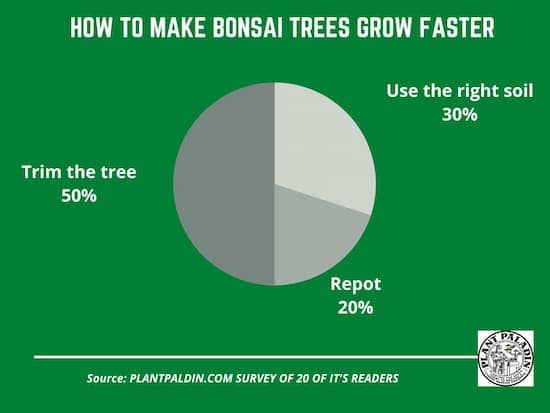
My top picks for the gear you will need!
So like I mentioned earlier, over the past three years of running PlantPaladin, hundreds of people have asked me for my recommendations on the best bonsai gear on the market.
Having spent thousands of dollars on bonsai items these past few years and tested at least 100 bonsai-specific products, I’ve listed my favorite products below – All of which I highly recommend and think you can get great value.
They can purchase directly by clicking the link to take them to Amazon.
Bonsai Tool Set: One of the significant challenges I’ve had is finding a toolset that was not only durable but didn’t break the bank. SOLIGT has recently developed a fantastic bonsai tool set that covers all the tools you need to trim, prune, and repot your trees. – You can grab it here.
Complete Bonsai Set: Many of you will want to grow your bonsai trees entirely from scratch, but finding the varicose seeds, pots, and other items in one place can be challenging. Leaves and Sole then have created a complete bonsai set that I’ve personally used that ticks all the boxes. You can grab it here.
Bonsai wire: The number of times I’ve run out of wire for my bonsai or purchased cheap bonsai wire that doesn’t do the job is embarrassing for me to admit. After a lot of trial and error, I found that using Hotop’s aluminum bonsai wire is one of the best options on the market. This can easily be used for both indoor and outdoor bonsai. You can grab it here.
